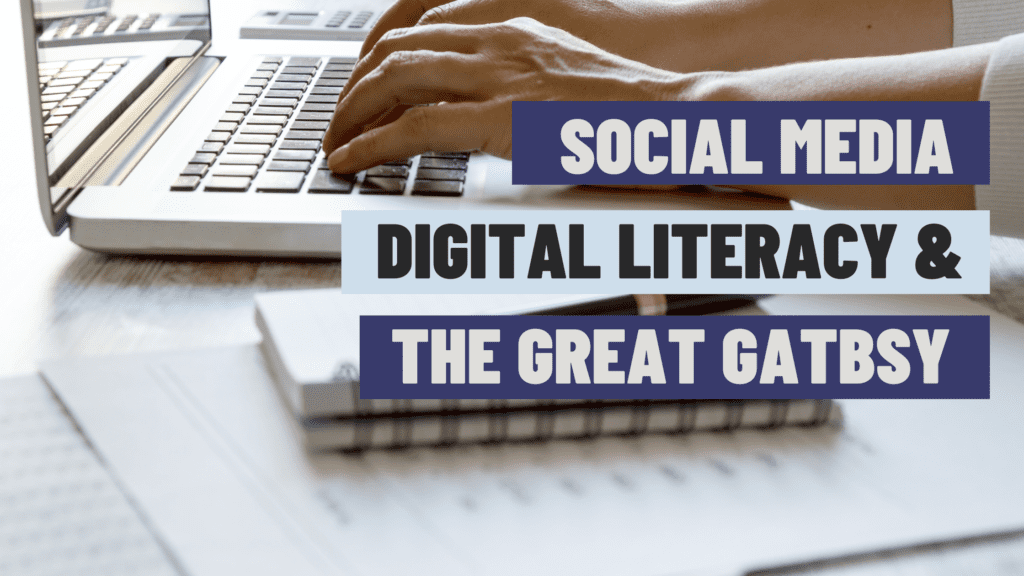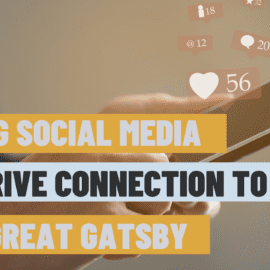In our fast-paced digital world, where instant gratification reigns supreme, it is essential to confront the allure of immediate fulfillment and its impact on our lives. This blog post aims to delve what The Great Gatsby teaches us about themes related to instant gratification and digital literacy. By examining the parallels between the desire for instant gratification on social media and the characters’ pursuit of immediate pleasures in the novel, we can initiate meaningful discussions about the potential dangers of prioritizing short-term satisfaction over long-term fulfillment.

Table of Contents
Confronting the Allure of Instant Gratification and its Consequences
Let’s explore how our digital culture has become coupled with the concept of instant gratification. Social media platforms, with their instantaneous feedback loops and viral content, have cultivated a society that craves immediate validation and fulfillment. We must encourage students to reflect on the implications of this desire for instant gratification in their own lives. By drawing connections between the characters’ pursuit of immediate pleasures in The Great Gatsby and the allure of instant gratification on social media, we can shed light on the deeper themes and messages conveyed in Fitzgerald’s work.
Multiple characters in the novel display their desire for instant gratification: Tom engages in an extramarital affair, displaying his dominance and ignoring the emotional well-being of those around him; Daisy embodies the superficiality of the 1920s, constantly seeking comfort and satisfaction. Myrtle is obsessed with the gifts Tom gives her and she believes that by having an with him it will improve her social class. Jay Gatsby has put in hard work, but he has taken shortcuts to achieve his wealth, hoping to regain Daisy’s affections. The seeking of instant gratification leads to the destruction of each character. These examples showcase what The Great Gatsby teaches us about the consequences of such choices and the universal relevance of this theme.
It is well known that social media users become addicted to the dopamine hit of a like, comment, or new follower. According to Forbes Advisor, “39% of U.S. online users admit to feeling the addictive pull of the digital rabbit hole that is social media, with 9% of these users agreeing completely with the statement ‘I am addicted to social media.’” This addiction is often tied to feelings of inadequacy. In May of 2023, the U.S. Surgeon General issued an advisory warning of the growing concern about the correlation between social media use and depression. Opportunities for our teens to engage in critical reflection are paramount to controlling their mental health. Timeless novels like The Great Gatsby can help teens to understand that while their specific circumstances are different, their motivations and reactions are a part of human nature. Knowing that they are not alone can help students better connect with the novel and also their world and those around them.
Nurturing Digital Literacy and Critical Thinking Skills
Transitioning from the allure of instant gratification, let’s address the pressing need for digital literacy and critical thinking skills in today’s digital landscape. It is crucial for students to develop the ability to analyze social media critically, question the reliability of information, and recognize the influence of media platforms on their perceptions and behaviors. Much like the unreliable narrator in The Great Gatsby, the digital realm requires a discerning eye. We can equip students with the necessary tools to navigate this realm by providing resources and activities that cultivate digital literacy and critical thinking skills, empowering them to engage with social media and literature thoughtfully.
We, as English teachers, understand the importance of application of analysis skills to everyday life. We can make the connection more explicit by discussing the role of critical thinking in analyzing social media content, including strategies for fact-checking, identifying biases, and recognizing inflammatory and misleading news. Teachers can guide students to discuss the impact of algorithms and evaluate the credibility of online sources. By emphasizing the relevance of these skills beyond the classroom, students can understand their broader significance in their personal and professional lives.
Implementing Ideas for Teaching The Great Gatsby
To conclude, let’s explore practical strategies for incorporating the discussed concepts into the classroom while teaching The Great Gatsby. Embracing technology can create interactive learning experiences that resonate with students. Virtual discussions and online collaboration tools enable thoughtful conversations and encourage the application of digital literacy and critical thinking skills. By leveraging technology effectively, educators can provide students with a rich and engaging learning environment that marries the themes of instant gratification and digital literacy within the context of The Great Gatsby. To further investigate, students could create social media profiles for the characters in the novel and analyze how their online presence reflects their desires for instant gratification.
In a different post, I looked at the mistakes teachers make when creating their Great Gatsby unit plans and included the danger of spending too much time on ineffectual context. But, a way that building context could really strengthen a unit and provide multiple opportunities to address curricular standards is by asking students to research and present on the historical context of the 1920s, comparing it to the current digital era and discussing the implications for society.
If your school has an SEL program, teachers can tie The Great Gatsby to these lessons. Connecting to digital media and ethics provides students with applications of what The Great Gatsby teaches us to real-world problems. By fostering interdisciplinary connections and integrating technology thoughtfully, educators can create immersive learning experiences that deepen students’ understanding of The Great Gatsby and its relevance in the digital age.
Conclusion
One of the key takeaways from what The Great Gatsby teaches us is about the perils of chasing immediate satisfaction. By delving into the characters’ relentless pursuit of instant pleasures and drawing parallels to our society’s obsession with instant validation through social media, we gain a deeper understanding of the consequences that arise from prioritizing short-term gratification over long-term fulfillment.
Bringing these lessons into the classroom, we can leverage technology to create engaging learning experiences that intertwine the themes of instant gratification and digital literacy. Virtual discussions, online collaboration tools, and multimedia projects provide students with the opportunity to delve deeply into The Great Gatsby while honing their digital skills.
In essence, what The Great Gatsby teaches us is that true fulfillment transcends the allure of immediate satisfaction. By embracing patience, self-reflection, and meaningful connections, we can find lasting fulfillment amidst a world driven by instant gratification. Through a balanced approach that combines literary analysis and digital literacy, we empower ourselves and future generations to navigate the complexities of our fast-paced world while gaining a deeper understanding of human nature and the pursuit of long-term fulfillment.
Products in My Store You May Be Interested In
- The Great Gatsby Chapter 1 Character Analysis and Social Media Jigsaw Activity – capitalize on your students interest and knowledge of social media and get them engaging and moving as they connect to the identity construction of character in American Dream Research Project for Teaching the Research Process – using a narrative process for synthesizing research, students will evaluate Hollywood’s portrayal of the American Dream.



